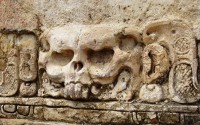The Mysterious Maya: an ancient American civilisation
- Date
- 26 Oct 2015
- Start time
- 7:30 PM
- Venue
- Tempest Anderson Hall
- Speaker
- Prof Norman Hammond

Prof Norman Hammond, Senior Fellow, McDonald Institute for Archaeological Research, Cambridge University.
Associate in Maya Archaeology, Peabody Museum, Harvard University, USA
The Maya of Central America created one of the great civilisations of the ancient world, in the unprepossessing environment of the tropical forest. Between 300 BC and AD 900, a succession of cities arose, with massive temples, palaces, ball-courts and other public buildings set around broad plazas in which stood carved and inscribed stelae depicting Maya kings. Although the cities of the Classic period such as Tikal, Palenque, Copan and Chichén Itzá have been explored for more than a century, new evidence on the rise and the fall of Maya civilisation has both resolved some of the mystery and raised new questions about this intriguing pre-Columbian society. Blood-sacrifice, warfare, dog-eating and drought have all proved important factors in the emerging Maya story.
NOTE: This lecture is on MONDAY evening in order to avoid a clash with the Sheldon Memorial Trust’s lecture
Member’s report
The Mayan classic period, 300-900 AD, is famous for its major cities, massive temples, pyramids, and palaces, set around broad plazas. Recent research has extended our knowledge of the birth of the civilization. Prehistoric hunters appeared 10,000 years ago, and pollen and carbon analysis shows farming at 3,350 years ago. Villages appeared 3,200 years ago, with mud-daub, timber-framed houses and sweat lodges, both very similar to those built today. Jewelry evidence suggests a stratified society by 2,600 years ago, and murals show kings by the 1st century BC. Sophisticated hieroglyphic writing started well before the 4th century AD and we can now read 90% of inscriptions. The heavy exploitation of farming land necessary for urban life was made possible by agricultural improvements, and by the introduction of drained fields, fish farming, irrigation, and terraced hill slopes. The civilization collapsed about 900AD due to a combination of warfare, droughts, food shortages, over-population, and social instability.
Rod Leonard